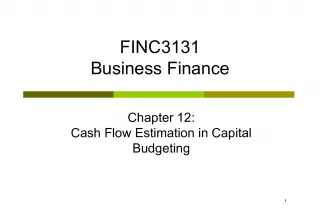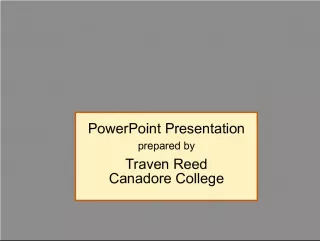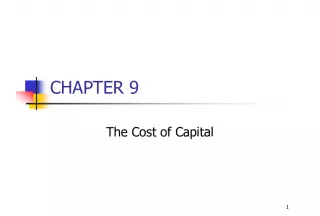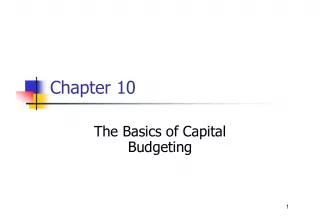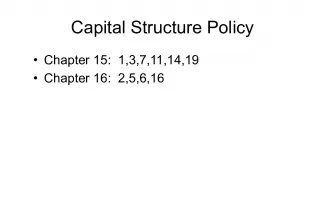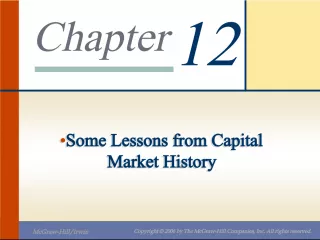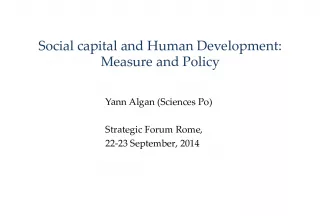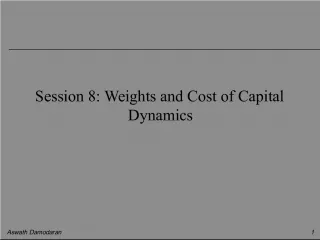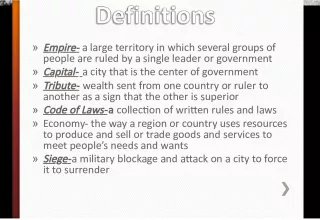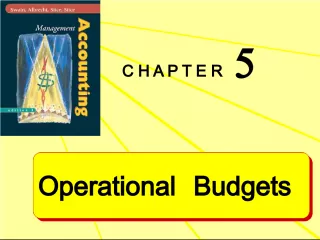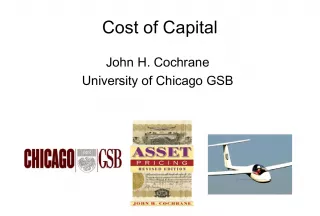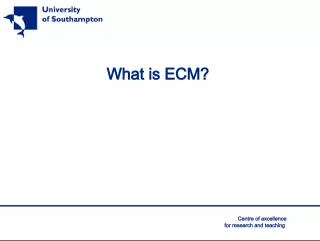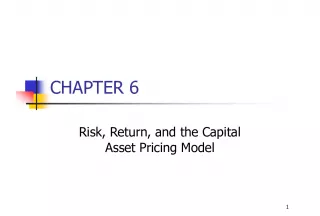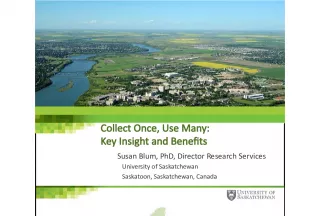Understanding Capital Budgeting at Drake University
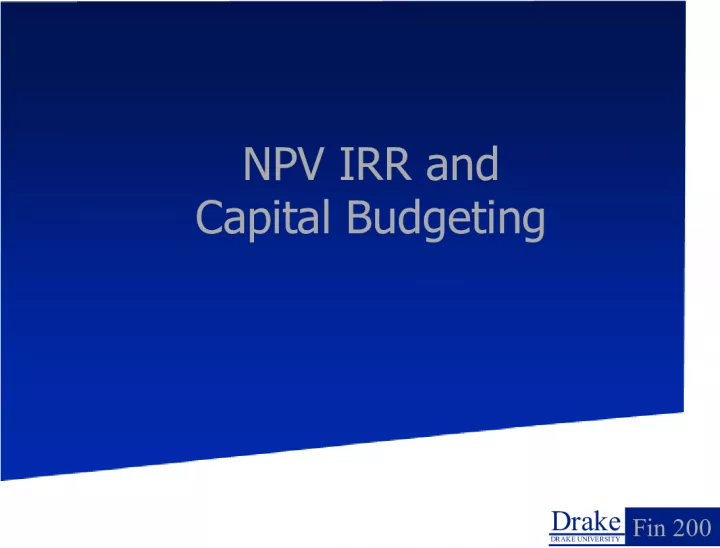

This article explores the principles of capital budgeting at Drake University, including NPV, IRR, and expenditure on long-term projects. It also explains independent projects and how to determine their acceptability.
- Uploaded on | 0 Views
-
 alexiis
alexiis
About Understanding Capital Budgeting at Drake University
PowerPoint presentation about 'Understanding Capital Budgeting at Drake University'. This presentation describes the topic on This article explores the principles of capital budgeting at Drake University, including NPV, IRR, and expenditure on long-term projects. It also explains independent projects and how to determine their acceptability.. The key topics included in this slideshow are Drake University, capital budgeting, NPV, IRR, long-term projects, independent projects, acceptability,. Download this presentation absolutely free.
Presentation Transcript
1. Drake DRAKE UNIVERSITY Fin 200 NPV IRR and Capital Budgeting
2. Drake Drake University Fin 200 Capital Budgeting Expenditures on projects that have a life greater than one year Long - Term Plans and lost flexibility
3. Drake Drake University Fin 200 Independent Projects Two projects are considered independent if undertaking one of them does not prevent us from considering the other The main question we will ask is whether or not a project is acceptable.
4. Drake Drake University Fin 200 Mutually Exclusive Projects Two projects are considered to be mutually exclusive when undertaking one project will preclude the other from being accepted. The criteria that causes this should be something other than cost. Ranking Mutually Exclusive Projects need accept / reject then rank the projects Timing of Cash Flows, Size of competing investments, Scarce Resources
5. Drake Drake University Fin 200 Project Valuation vs.. Security Valuation Estimate the future cash flows Determine the appropriate interest rate Find the PV of the positive cash flows Compare the PV to the cost
6. Drake Drake University Fin 200 What Cash Flow? The incremental changes to cash flow that result from the project.
7. Drake Drake University Fin 200 Incremental Cash Flow Cash flow changes that result from a particular project Relevant Cash Outflows Increase Cash outflow Elimination of cash inflow Investment in Assets Relevant Cash Inflow Increase in cash inflow Elimination of cash outflow Liquidation of assets
8. Drake Drake University Fin 200 Capital Budgeting Decision Tools Net Present Value Payback Period and Discounted Payback Internal Rate of Return & Modified IRR Profitability Index and Modified Profitability index
9. Drake Drake University Fin 200 Net Present Value The sum of the PV of the positive cash flows minus the PV of negative cash flows and the initial cost or
10. Drake Drake University Fin 200 NPV Accept or Reject If the NPV is positive the PV of the benefits is greater than the PV of the cost -- You should accept the project (The value of the firm will increase if the project is accepted) If the NPV is negative, The PV of the benefits is less than the PV of the cost -- You should reject the project (The value of the firm would decrease if the project is accepted)
11. Drake Drake University Fin 200 NPV Example Assume a project cost of capital of 10% Year Cash Flow Present Value 0 -1,000 -1,000.00 1 1,000 909.90 2 -2,000 -1,652.89 3 3,000 2,253.94 NPV = 510.14
12. Drake Drake University Fin 200 Calculator HP 10B -1,000
13. Drake Drake University Fin 200 The Required Return What interest rate should be used to discount the cash flows? The project cost of capital WHY?
14. Drake Drake University Fin 200 NPV Note, as in the case of our bond and stock valuation models there will be an inverse relationship between the required return and the NPV. A lower Cost of Capital increases the NPV of the project (And the value of the firm)
15. Drake Drake University Fin 200 Special Case What if the project is expected to return cash flows that grow at a constant rate forever and the only outlay is at the beginning of the project? Use the constant growth formula (Stock Valuation)
16. Drake Drake University Fin 200 Internal Rate of Return The IRR is the required return that makes the NPV of a project equal to zero. If IRR is greater than the hurdle rate (the project cost of capital) Accept the project IF IRR is less than the hurdle rate (the project cost of capital) Reject the project
17. Drake Drake University Fin 200 IRR and NPV IRR and NPV will always provide the same accept / reject decision WHY???? IRR is the rate that makes NPV zero If: Project cost of capital < IRR accept the project, this also implies a positive NPV (inverse relationship) If Project Cost of Capital > IRR reject the project , this also implies a negative NPV
18. Drake Drake University Fin 200 IRR Benefits Intuitive Measure of risk compared to WACC
19. Drake Drake University Fin 200 IRR Problems Ignores size and amount of wealth created Ignores project life It is possible to have multiple IRRs
20. Drake Drake University Fin 200 Multiple IRRs Time Cash Flow 0 -100 1 275 IRR = 7.4% and 67.6% 2 -180 Time Cash Flow 0 100 1 -275 IRR = 7.4% and 67.6% 2 180
21. Drake Drake University Fin 200 Multiple IRRs vs. NPV Time Cash Flow 0 -100 1 275 NPV @ 15% = $3 2 -180 Time Cash Flow 0 100 1 -275 NPV @ 15% = -$3 2 180
22. Drake Drake University Fin 200 Multiple IRRs An easy check for Multiple IRRs Mathematically the largest number of IRRs that is possible equals the number of sign changes in the cash flow stream
23. Drake Drake University Fin 200 Modified IRR The discount rate that makes the PV of the projects costs equal the PV of the terminal value of the project Terminal Value = the FV of the positive Cash flows compounded at the cost of capital
24. Drake Drake University Fin 200 Example Cost of Capital = 10% Time Cash Flow PV FV 0 -1000 -1000 1 500 665.50 2 400 484.00 3 -150 -112.69 4 500 500.00 -1,112.69 1,649.50 1112.69 = 1649.50/(1+MIRR) 4 MIRR = 10.34%
25. Drake Drake University Fin 200 Payback Period Intuition: Measures length of time it takes for the firm to payback the original investment. Simple example: Cost = 100,000 Cash Flow = 20,000 a year Payback = Cost / Cash Flows = 100,000 / 20,000 = 5 years
26. Drake Drake University Fin 200 Payback Period Most problems do not work out even. You need to look at the cumulative cash flow and compare to the initial cost.
27. Drake Drake University Fin 200 Calculating Payback Period Calculate the cumulative cash flow (total cash flow received) Calculate the Remaining Cost (Total Cost - Cumulative Cash Flow) Repeat 1 and 2 until remaining cost is less than zero In last positive year divide remaining cash flow by yearly cash flow in next year Calculate total payback
28. Drake Drake University Fin 200 Example: Initial Cost = 100,000 Yearly Cumulative Remaining YR Cash Flow Cash Flow Cash Flow 1 40,000 40,000 60,000 2 30,000 70,000 30,000 3 25,000 95,000 5,000 4 20,000 115,000 -15,000 Payback = 3 + 5,000/20,000 = 3.25
29. Drake Drake University Fin 200 Payback Period: Benefits Easy to Understand and Interpret Reject / Accept based on a Minimum payback Provides measure of risk
30. Drake Drake University Fin 200 Payback Period Weaknesses Ignores Time Value of Money Ignores all cash flows after the payback
31. Drake Drake University Fin 200 Discounted Payback Period Attempts to account for time value of money by evaluating the yearly cash flows in their present value.
32. Drake Drake University Fin 200 Calculating Discounted Payback Period Calculate the PV of each cash flow Calculate the cumulative present value of the cash flow s(total cash flow received) Calculate the Remaining Cost (Total Cost - Cumulative PV Cash Flow) Repeat 1 and 2 until remaining cost is less than zero In last positive year divide remaining cash flow by yearly cash flow in next year Calculate total payback
33. Drake Drake University Fin 200 Initial Cost=100,000 r = 10% Yearly PV Cumul Remaining YR CF CF CF CF 1 40,000 36,364 36,364 63,636 2 30,000 24,793 61,157 38,843 3 25,000 18,783 79,940 20,060 4 20,000 13,660 93,600 6,400 5 15,000 9,314 102,914 -2,914 Payback = 4 + 6400/9314 = 4.687
34. Drake Drake University Fin 200 Discounted Payback Weakness: Still ignores cash flows after payback Strengths: Accounts for time value of money, easy to understand and calculate, risk measure Accept / Reject -- Set Minimum payback and compare
35. Drake Drake University Fin 200 Profitability Index Measures the value created per dollar invested
36. Drake Drake University Fin 200 PI If the PI is greater than 1 accept the project (NPV is positive) If the PI is less than 1 reject the project (NPV is negative) If PI = 1.45 it would imply that the project will produce $1.45 for each $1 invested.
37. Drake Drake University Fin 200 Modified PI The basic PI does not account for the possible future costs, modified PI attempts to do this:
38. Drake Drake University Fin 200 Modified PI Same Accept Reject decision as regular PI
39. Drake Drake University Fin 200 Mutually Exclusive NPV provides the best ranking when comparing between mutually exclusive investments, The rest can produce inconsistent rankings
40. Drake Drake University Fin 200 Example Project Initial Cost YR1 CF YR2 CF A 1,000,000 1,000,000 0 B 1,200,000 1,119,000 312,000 C 900,000 195,000 970,000 D 1,100,000 980,000 345,000 Compare the different methods for both 7%and 12% (in Class)
41. Drake Drake University Fin 200 Comparison of results
42. Drake Drake University Fin 200 IRR vs. NPV revisited Investment Cost YR 1 IRR A 10,000 12,000 20% B 15,000 17,700 18% NPV@12% NPV@16% A 714 344.82 B 803.50 258.60 NPV@14% 526.31579 for both
43. Drake Drake University Fin 200 On the Graph 14% 526.32 18% 20% 2,000 2,700
44. Drake Drake University Fin 200 Quick Review Method Accept Reject Payback Payback < cutoff Payback>cutoff Disc. Payback Same as Payback NPV NPV > 0 NPV < 0 IRR IRR > WACC IRR < WACC MIRR MIRR >WACC MIRR < WACC PI PI > 1 PI < 1 MPI MPI > 1 MPI < 1
45. Drake Drake University Fin 200 Summary Use NPV as the first rule The other criteria can provide secondary information Which Criteria is most often used by managers?
